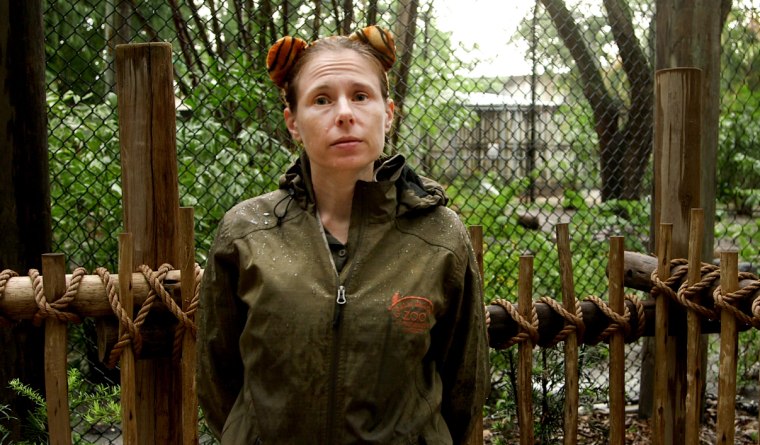When a Malayan tiger — an endangered cat that can grow to nearly 300 pounds — attacked Palm Beach Zoo keeper Stacey Konwiser last Friday, zoo officials had two options: They could use deadly force on the tiger, or they could tranquilize him.
Attempting to fatally shoot an animal that's mauling a human comes with the risk of accidentally shooting the person you're trying to save. But tranquilizers can take as long as 10 minutes to kick in, letting potentially life-saving minutes tick by while the animal is still alert enough to pose a threat.
Palm Beach Zoo chose to tranquilize the tiger, and Konwiser, 38, was airlifted in critical condition to a hospital, where she later died of her injuries.

Since then, the zoo has come under fire for its choice to "tranq," which West Palm Beach police say prevented paramedics from immediately entering the zoo enclosure where Konwiser was mauled. Neither police nor the zoo have said how long emergency personnel had to wait, citing the ongoing investigation.
Related: Florida Zookeeper Killed by Tiger to Be Memorialized by 5K Run
The zoo stands by its decision, Palm Beach Zoo spokeswoman Naki Carter told NBC News on Thursday.
"We are equipped to tranquilize and we are equipped to shoot to kill," Carter said. "There are a lot of things to consider."
The kind of ammunition that would have taken down the animal "comes with a series of checks and balances," she added. "All those things have to be factored in. And based on what we know at this time, we are equipped to do both, and we stand by the decision to tranq."
Fatal attacks on humans by big cats in captivity have happened before: Since 1990, there have been 24 such deaths in the U.S., according to the Animal Legal Defense Fund.
All accredited zoos such as Palm Beach's have protocols in place for when an animal threatens zoo staff or the public.
"I think it would be helpful if you view this to how a police officer would react if he or she is confronted with a dangerous individual. There is a decision tree, or a progressive use of force, that has to be considered with every incident," Ed Hansen, CEO of the American Association of Zoo Keepers, told NBC News.
Related: Zoo Where Keeper Was Mauled Has Had Other Incidents
Zoos have trained shooters who are educated on weapon caliber, use of force, and circumstances under which to discharge weapons.
"The first item is, is the animal contained?" Hansen said. In the Palm Beach Zoo case, it was: Konwiser was in an enclosure where the tigers typically eat and sleep, and the tiger never posed danger to the public. "The second item is, can you separate the dangerous animal from the victim?"
Officials can create distance from an animal using non-lethal means, such as spraying a fire extinguisher at it. If that's not possible — not enough information has been released about Konwiser's situation to know — "this is where it gets very, very tricky," Hansen said.
"You have to use a high-caliber weapon, a rifle or a shotgun" to humanely kill the tiger, he said. "If you were looking at a small space, concrete construction holding area, you may not want to discharge a high-caliber weapon in that environment because it may ricochet or cause further complications. You could injure the shooter or additionally injure the victim."
"There's an old saying that you can take an animal out of the wild, but you can never take the wild out of the tiger."
At Zoo Miami, where an animal keeper was killed by a tiger in 1994, if a cat or other large carnivore poses an imminent threat to people, "unfortunately that is a death sentence for that animal," communications director Ron Magill told NBC News.
"Our policy would be yes, if a tiger is on top of a human being here, we're not going to anesthetize it. We're going to shoot it to facilitate rescuing that human as quickly as possible."
"Seconds count in trying to save someone's life," he added.
David Hitzig, the executive director of the Busch Wildlife Sanctuary in Jupiter, Florida, echoed that.
"Human life is always going to take precedence," he told NBC News. "You always want the opportunity to be able to tranquilize the animal ... But when you run into a situation where obviously you have human life in jeopardy, whether it's in a confined area or whether you have an animal escape and you're not in control of the situation, then you have to look at lethal means."
The experts all agree that Konwiser's death wasn't the tiger's fault. The sound of her rustling inside the enclosure could have surprised him, or he may have even been playing when he killed her.
"There's an old saying that you can take an animal out of the wild, but you can never take the wild out of the tiger," Magill said. "This is a constant danger that exists within our job."
There would be no reason to euthanize this tiger now, after the fact, because if proper zoo protocols are followed, he is no more dangerous to humans than any other big cat, Magill added.
"The tiger was being a tiger. He wasn't a mean tiger, he wasn't a bad tiger," he said. "He was a tiger."
Agencies including the Florida Fish and Wildlife Conservation Commission and the Occupational Safety and Health Administration are investigating Konwiser's death.
